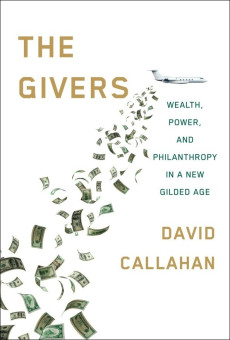
The Givers: Wealth, Power, and Philanthropy in a New Gilded Age
David Callahan
329 pages, Knopf, 2017
In The Givers: Wealth, Power, and Philanthropy in a New Gilded Age, David Callahan documents the rising influence of a new philanthropic elite: ultra-wealthy donors who want to put vast resources to immediate use. Previous generations of elite benefactors might have been content to put their names on buildings or “legacy foundations,” but today’s givers want results. “They have enough money to try to make change in society, and they know it,” Callahan writes. The concern from a democratic point of view is that many think these millionaires and billionaires have more than enough power already.
Callahan is the founder and editor of the website Inside Philanthropy. His new book demonstrates the breadth of his knowledge of the sector. Individual chapters investigate different dimensions of elite philanthropy today and discuss cases from diverse sectors (from education to economic policy to human rights) and across the political spectrum. The Givers should attract broad interest: Callahan is an engaging narrator, and the book has a timely message about the growing political significance of elite philanthropy.
The book is particularly good at capturing something that discussions of elite philanthropy often miss: The distance between elite “charity” and elite political influence is small and shrinking. The philanthropists profiled here are strategic actors trying to bring about particular outcomes, and they are eager to use their influence in a range of sectors to do so. Foundations interested in changing the educational sphere might spend money both to support charter schools and to lobby for school privatization policies. We often think of charitable donations and elite political influence as categorically distinct activities, but Callahan’s subjects are Good Samaritans and political animals at the same time.
There are both advantages and drawbacks to Callahan’s choice to view philanthropy through the lens of elite behavior. At times, he seems to hew too closely to the perspective of the elite donors he profiles. He gleans insights into the motives of the billionaire signatories of the Gates-Buffett Giving Pledge from the public letters that pledgers submit upon joining. From this we learn that many elite donors are trying to “give back” to their communities and promote a vision of the public good. Some see themselves as countervailing forces to other kinds of undemocratic influence, such as wealthy families that don’t donate to less advantaged communities. But there are limits to what we can learn from such sources. We shouldn’t rely on them any more than we would rely on a political candidate’s press releases to predict her behavior once in office. The book is at its strongest when Callahan shows that from a democratic perspective, donors’ motivations matter less than the results of their actions.
To make better sense of elite philanthropy, it would be helpful if Callahan spent more time mapping the relationships between donors, recipient organizations, formal political actors, and the broader public. Callahan gives us a much more complete picture of the funders than of other relevant actors. The preferences of wealthy donors drive Callahan’s case selection, and he sometimes seems to assume rather than demonstrate the overriding influence of the rich. For example, he briefly describes the effective altruism movement by profiling billionaire couple Cari Tuna and Facebook cofounder Dustin Moskovitz and their foundation Good Ventures. Alternative lenses would interpret evidence-based, welfare-promoting philanthropy such as effective altruism as a triumph of Internet-based social movements, or of consequentialist moral philosophy, rather than of individual wealthy donors.
Focusing on the activities of billionaires makes it difficult to weigh the relative importance of different actors. We don’t get much sense of how these elites interact with other players. And that also makes it difficult to evaluate the reforms (including increased transparency and changes to the charitable tax deduction systems) that Callahan recommends in his concluding chapter.
Callahan’s primary aim is to document the rising influence and political significance of elite philanthropy. But he doesn’t make a strong argument about if and how elite philanthropy is or isn’t compatible with democratic values. Instead, he emphasizes that many people feel ambivalent about philanthropic funders: We commend their generosity but feel uneasy about their outsized power. Philanthropy has become “deeply enmeshed in the machinery of civic life.” Sometimes the results seem self-evidently good: “Parks, libraries, and museums make cities livable; top universities and medical research centers make them great, attracting talent from around the world. What’s not to like?” As Callahan writes, “Maybe a bunch of things … from who is making choices over public life to who actually benefits from those choices.”
These ideas suggest at least two different standards for evaluating elite philanthropy. Should we care most about “who actually benefits”? If so, then what matters is ensuring that philanthropy produces public benefits untainted by private interest. This might be an attractive standard, but it is not a particularly democratic one: Philanthropy becomes a form of “beneficent elite rule.”
On the other hand, if the key question is “Who is making choices over public life?” then what matters is a more equal distribution of opportunity to influence policy. I would have liked to hear more from Callahan on these big-picture questions. Are we chasing better outcomes or a more equal distribution of power? Are elite philanthropists a counterweight to other, self-interested elites—or to democracy itself? For now, these fundamental questions remain buried under the wealth of information in this book.

